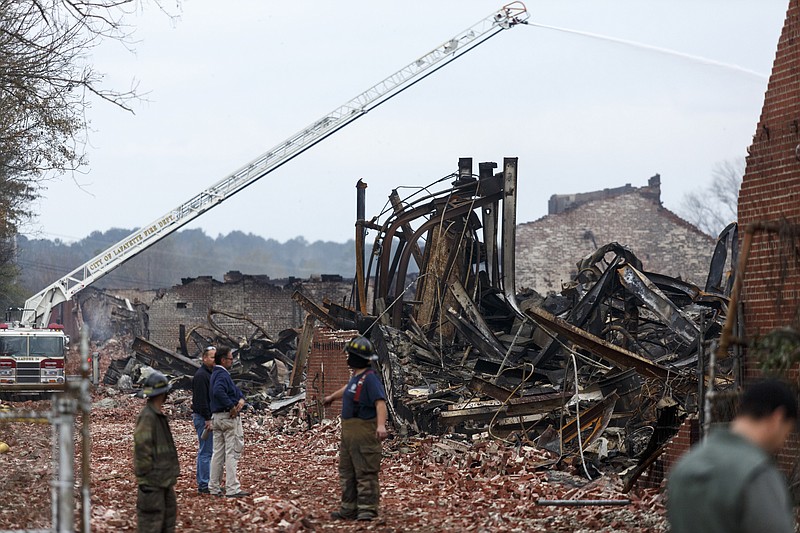The tedious process of managing the site of a massive fire at a largely abandoned plant in LaFayette, Ga., is at an early crossroads.
Officials tasked with cleaning up the wreckage of the old Barwick Mills plant that erupted in flames in mid-November are expected to learn this week whether the charred remains of the building contain asbestos.
What they learn will dictate the course and the cost - both in time and money - of a demolition and cleanup process expected by city officials to last at least six to nine months.
"Last week, we took asbestos samples and we're awaiting the laboratory results from those samples to determine how the proposed plan will be amended, modified and implemented," said Barry Holbert, a senior engineer with Maxis Engineering.
Maxis Engineering and Global Environmental are the two companies managing the cleanup with oversight from the federal Environmental Protection Agency and Georgia's Environmental Protection Division.
The companies submitted a proposed demolition plan to those agencies last week detailing how potential asbestos issues would be dealt with. The plan will have to be fine-tuned and approved by the EPA and EPD once the results of the asbestos sampling come back.
High levels of what has repeatedly been termed as "particulate matter" were released into the air surrounding the plant after the fire, causing nearby air quality to be deemed "unsafe" the day after the blaze, according to air tests detailed in a report released by the EPA last month.
LaFayette residents were advised to stay indoors the night after the fire, which took several days to extinguish and produced a smoke cloud visible for miles. No cause of the fire has been released.
Decades ago, the building was a carpet factory but it was largely vacant at the time of the fire. The sole tenant at the time of the blaze was a Chattanooga-based company, Ashgan Products, that stored biodegradable products in the south side of the building.
"From a hazardous waste standpoint with what was being stored there, it wasn't anything of major concern," Holbert said. "It's really asbestos that is the main concern from the EPD and the EPA."
Runoff from the firefight settled in the Chattooga River, turning the water a filmy blue in the hours after the fire started and sparking speculation that dye left over from a previous tenant was polluting the water.
Concerns over any potential leftover chemicals from previous tenants has largely dissipated, with officials focusing on what they know to have been inside the facility.
But a fine could be assessed to the building owner based on the results of a report that will detail the number of fish killed in the initial runoff.
Hugh Galyon from the EPD said Monday the report has not been finalized.
"I would hope that it will be [finalized] by the end of the month," Galyon said.
For now, the focus in LaFayette is on securing the site and containing the remaining water from the firefight until the results of the asbestos tests return and demolition can begin.
"If there is asbestos, you just have to manage it so it doesn't become airborne," Holbert said. "Asbestos, it's kind of overblown. But if the building has asbestos, essentially you manage it by covering it, wetting it to make sure you keep dust down. And then it has to be taken to a solid waste management landfill."
Asbestos, according to the National Cancer Society, is a group of minerals that occur naturally in the environment and can be woven into fabrics or separated into thin, durable threads.
It has long been used in the industrial sector and can be hazardous when breathed in, because it can accumulate in the lungs, causing scarring and inflammation that can affect breathing and cause other health issues, including mesothelioma.
Contact staff writer David Cobb at dcobb@timesfreepress.com or 423-757-6249.

